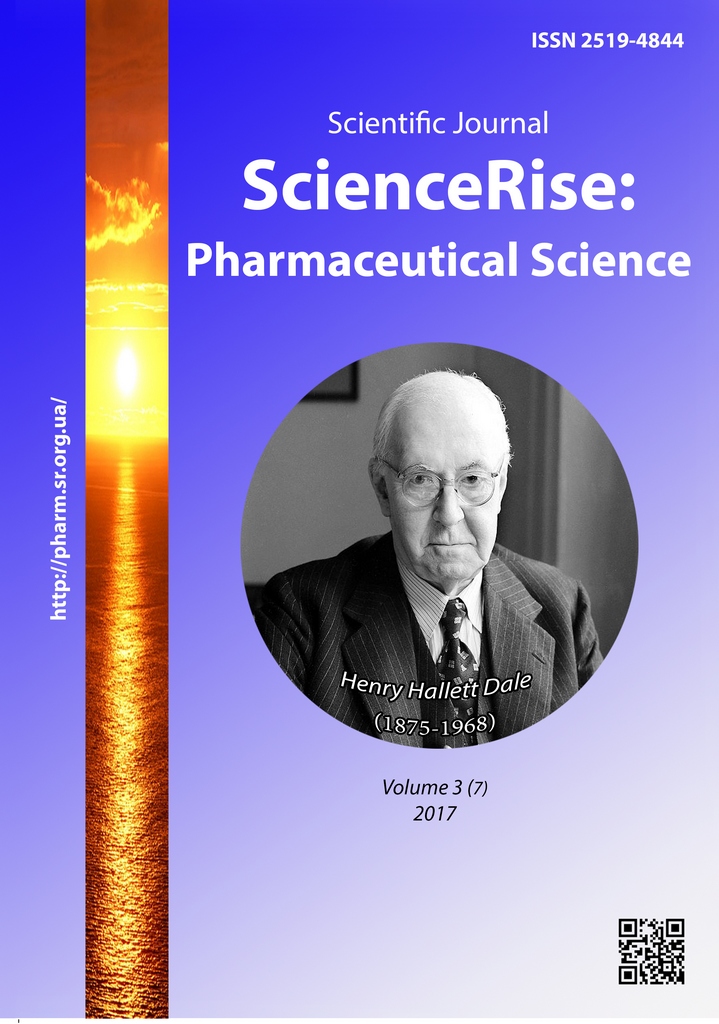Wood anemone. Anemone Nemorosa L. Analytical review
DOI:
https://doi.org/10.15587/2519-4852.2017.104438Keywords:
Ranunculaceae, Anemone nemorosa, Protoanemonin, biologically active compounds, pharmacological activityAbstract
Literature sources were analyzed and the data concerning the range, biologically active compounds content and the use in pharmacy and medicine of Anemone nemorosa were summarized.
The aim of research is implementation of Anemone nemorosa in pharmaceutical and medical practice. Anemone nemorosa is a perennial herb of the buttercup (Ranunculaceae) family. This herb is non-officinal, but it is widely used in traditional medicine as an antitumor, anti-inflammatory, antispasmodic, sedative, diaphoretic, bactericidal, antimicrobial, antifungal, expectorant, and diuretic agent. The main biologically active substances of Anemone nemorosa are alkaloids, glycosides (Protoanemonin, Anemonin, Ranunculine, some types of saponins, tannins), vitamin C, resins, organic acids (chelidonic acid), coumarins, flavonoids and γ-linolenic acid.
The plant belongs to the regionally rare plants of Ukrainian administrative territories, therefore, despite the results of phytochemical and pharmacological studies, it becomes clear that the further use of Anemone nemorosa as a medicinal herb is an important issue for pharmacy and pharmaceutical biotechnology due to the prospects of research in area of new herbal remedies creation.
Due to extensive experience of use in traditional medicine, a wide range of pharmacological activity, the content of biologically active compounds, Anemone nemorosa is a promising and valuable herbal material for phytochemical remedies production and their practical implementationReferences
- Shavel, I. (2012). Tsilushchi roslyny Ukrainy [Healing plants of Ukraine]. Lviv: BaK, 432.
- Christopher, C. (2013). Encyclopedia of Cultivated Plants: From Acacia to Zinnia 3 Vol.: From Acacia to Zinnia. Santa Barbara, 1236.
- Grodzinskyi, A. M. (Ed.) (1992). Likarski roslyny: Entsyklopedychnyi dovidnyk [Encyclopedic Reference of medicinal plants]. Kyiv: Publishing "Ukrainian Encyclopedia" named after Bazhan M. P., 544.
- Kozoriz, O. (Ed.) (2007). Likarski roslyny Karpat. Dykorosli ta culturni. [Medicinal plants of the Carpathians. Wild and cultural]. Uzhgorod: Mystets'ka Liniya, 504.
- Zemlynskyi, S. E. (1952). Lekarstvennye rastenyia SSSR [Medicinal plants of the USSR]. Moscow: Publishing house of the Moscow Society of Naturalists, 507.
- Red Book of Ukraine (2010–2017). Available at: http://redbook-ua.org/
- Anemone (Wood) (1995–2017). Available at: http://Botanical.com/
- Mondoni, A., Probert, R., Rossi, G., Hay, F., Bonomi, C. (2008). Habitat-correlated seed germination behaviour in populations of wood anemone ( Anemone nemorosa L.) from northern Italy. Seed Science Research, 18 (4), 213–222. doi: 10.1017/s0960258508084997
- Hao, D.-C., Gu, X., Xiao, P. (2017). Anemone medicinal plants: ethnopharmacology, phytochemistry and biology. Acta Pharmaceutica Sinica, 7 (2), 146–158. doi: 10.1016/j.apsb.2016.12.001
- Tsevegsuren, N., Aitzetmuller, K. (1993). 7-Linolenic Acid in Anemone spp. Seed Lipids. Institute for Chemistry and Physics of Lipids, Federal Center for Cereals, Potato and Lipid Research (BAGKF), 28 (9), 841–846. doi: 10.1007/BF02536240
- Frohne, D., Pfander, H. J. (2005). Poisonous Plants: a handbook for doctors, pharmacists toxicologists, biologists and veterinarians. London: Manson Publishing Inc., 480.
- Minakata, H., Komura, H., Nakanishi, K., Kada, T. (1983). Protoanemonin, an antimutagen isolated from plants. Mutation Research/Genetic Toxicology, 116 (3-4), 317–322. doi: 10.1016/0165-1218(83)90069-1
- Martin, M., Roman, L., Dominguez, A. (1990). In VitroActivity of Protoanemonin, an Antifungal Agent. Planta Medica, 56 (1), 66–69. doi: 10.1055/s-2006-960886
- Bobadilla Fazzini, R. A., Skindersoe, M. E., Bielecki, P., Puchalka, J., Givskov, M., Martins dos Santos, V. A. P. (2012). Protoanemonin: a natural quorum sensing inhibitor that selectively activates iron starvation response. Environmental Microbiology, 15 (1), 111–120. doi: 10.1111/j.1462-2920.2012.02792.x
- Roth, L., Daunderer, M., Kormann, K. (2006). Poisonous plants-phytotoxins. Hamburg.
- Misra, S. B., Dixit, S. N. (1980). Antifungal principle ofRanunculus sceleratus. Economic Botany, 34 (4), 362–367. doi: 10.1007/bf02858312
- Maior, M., Dobrota, C. (2013). Natural compounds with important medical potential found in Helleborus sp. Open Life Sciences, 8 (3), 272–285. doi: 10.2478/s11535-013-0129-x
- Huang, Y.-H., Lee, T.-H., Chan, K.-J., Hsu, F.-L., Wu, Y.-C., Lee, M.-H. (2008). Anemonin is a natural bioactive compound that can regulate tyrosinase-related proteins and mRNA in human melanocytes. Journal of Dermatological Science, 49 (2), 115–123. doi: 10.1016/j.jdermsci.2007.07.008
- Hu, Y., Chen, X., Duan, H., Hu, Y., Mu, X. (2009). Pulsatilla decoction and its active ingredients inhibit secretion of NO, ET-1, TNF-α, and IL-1αin LPS-induced rat intestinal microvascular endothelial cells. Cell Biochemistry and Function, 27 (5), 284–288. doi: 10.1002/cbf.1570
- Duan, H., Zhang, Y., Xu, J., Qiao, J., Suo, Z., Hu, G., Mu, X. (2006). Effect of anemonin on NO, ET-1 and ICAM-1 production in rat intestinal microvascular endothelial cells. Journal of Ethnopharmacology, 104 (3), 362–366. doi: 10.1016/j.jep.2005.09.034
- Lee, T. H., Huang, N. K., Lai, T. C., Yang, A. T. Y., Wang, G. J. (2008). Anemonin, from Clematis crassifolia, potent and selective inducible nitric oxide synthase inhibitor. Journal of Ethnopharmacology, 116 (3), 518–527. doi: 10.1016/j.jep.2007.12.019
- Jia, D., Han, B., Yang, S., Zhao, J. (2014). Anemonin Alleviates Nerve Injury After Cerebral Ischemia and Reperfusion (I/R) in Rats by Improving Antioxidant Activities and Inhibiting Apoptosis Pathway. Journal of Molecular Neuroscience, 53 (2), 271–279. doi: 10.1007/s12031-013-0217-z
- Xiao, K., Cao, S. T., Jiao, L. F., Lin, F. H., Wang, L., Hu, C. H. (2016). Anemonin improves intestinal barrier restoration and influences TGF-β1 and EGFR signaling pathways in LPS-challenged piglets. Innate Immunity, 22 (5), 344–352. doi: 10.1177/1753425916648223
- Althea officinalis, Anemone nemorosa, Anemone sylvestris: Description of plants. Available at: http://ru.osvita.ua/vnz/reports/biolog/27498/
- Chekman, I. S. (2003). Klinichna phifoterapiia [Clinical phytotherapy]. Kyiv: A.S.K., 552.
Downloads
Published
How to Cite
Issue
Section
License
Copyright (c) 2017 Anna Lukianchuk, Oksana Khropot, Yulian Konechnyi, Roksolana Konechna, Volodymyr Novikov

This work is licensed under a Creative Commons Attribution 4.0 International License.
Our journal abides by the Creative Commons CC BY copyright rights and permissions for open access journals.








